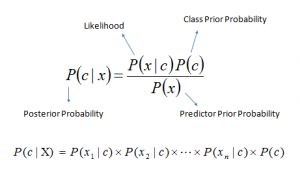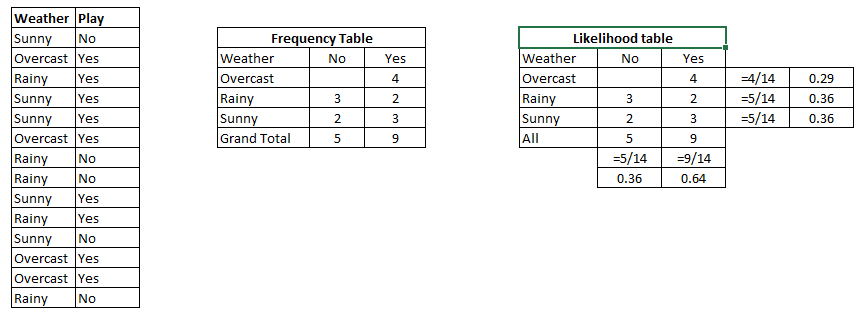Risk of Bayes Classifier Continuous Output
Sunil Ray — Published On September 11, 2017 and Last Modified On August 26th, 2021
Note: This article was originally published on Sep 13th, 2015 and updated on Sept 11th, 2017
Overview
- Understand one of the most popular and simple machine learning classification algorithms, the Naive Bayes algorithm
- It is based on the Bayes Theorem for calculating probabilities and conditional probabilities
- Learn how to implement the Naive Bayes Classifier in R and Python
Introduction
Here's a situation you've got into in your data science project:
You are working on a classification problem and have generated your set of hypothesis, created features and discussed the importance of variables. Within an hour, stakeholders want to see the first cut of the model.
What will you do? You have hundreds of thousands of data points and quite a few variables in your training data set. In such a situation, if I were in your place, I would have used 'Naive Bayes', which can be extremely fast relative to other classification algorithms. It works on Bayes theorem of probability to predict the class of unknown data sets.
In this article, I'll explain the basics of this algorithm, so that next time when you come across large data sets, you can bring this algorithm to action. In addition, if you are a newbie in Python or R, you should not be overwhelmed by the presence of available codes in this article.
If you prefer to learn Naive Bayes theorem from the basics concepts to the implementation in a structured manner, you can enroll in this free course:
- Naive Bayes from Scratch
Are you a beginner in Machine Learning? Do you want to master the machine learning algorithms like Naive Bayes? Here is a comprehensive course covering the machine learning and deep learning algorithms in detail –
- Certified AI & ML Blackbelt+ Program
Project to apply Naive Bayes
Problem Statement
HR analytics is revolutionizing the way human resources departments operate, leading to higher efficiency and better results overall. Human resources have been using analytics for years.
However, the collection, processing, and analysis of data have been largely manual, and given the nature of human resources dynamics and HR KPIs, the approach has been constraining HR. Therefore, it is surprising that HR departments woke up to the utility of machine learning so late in the game. Here is an opportunity to try predictive analytics in identifying the employees most likely to get promoted.
Practice Now
Table of Contents
- What is Naive Bayes algorithm?
- How Naive Bayes Algorithms works?
- What are the Pros and Cons of using Naive Bayes?
- 4 Applications of Naive Bayes Algorithm
- Steps to build a basic Naive Bayes Model in Python
- Tips to improve the power of Naive Bayes Model
What is Naive Bayes algorithm?
It is a classification technique based on Bayes' Theorem with an assumption of independence among predictors. In simple terms, a Naive Bayes classifier assumes that the presence of a particular feature in a class is unrelated to the presence of any other feature.
For example, a fruit may be considered to be an apple if it is red, round, and about 3 inches in diameter. Even if these features depend on each other or upon the existence of the other features, all of these properties independently contribute to the probability that this fruit is an apple and that is why it is known as 'Naive'.
Naive Bayes model is easy to build and particularly useful for very large data sets. Along with simplicity, Naive Bayes is known to outperform even highly sophisticated classification methods.
Bayes theorem provides a way of calculating posterior probability P(c|x) from P(c), P(x) and P(x|c). Look at the equation below:
 Above,
Above,
- P(c|x) is the posterior probability of class (c,target) given predictor (x,attributes).
- P(c) is the prior probability of class.
- P(x|c) is the likelihood which is the probability of predictor given class.
- P(x) is the prior probability of predictor.
How Naive Bayes algorithm works?
Let's understand it using an example. Below I have a training data set of weather and corresponding target variable 'Play' (suggesting possibilities of playing). Now, we need to classify whether players will play or not based on weather condition. Let's follow the below steps to perform it.
Step 1: Convert the data set into a frequency table
Step 2: Create Likelihood table by finding the probabilities like Overcast probability = 0.29 and probability of playing is 0.64.

Step 3: Now, use Naive Bayesian equation to calculate the posterior probability for each class. The class with the highest posterior probability is the outcome of prediction.
Problem: Players will play if weather is sunny. Is this statement is correct?
We can solve it using above discussed method of posterior probability.
P(Yes | Sunny) = P( Sunny | Yes) * P(Yes) / P (Sunny)
Here we have P (Sunny |Yes) = 3/9 = 0.33, P(Sunny) = 5/14 = 0.36, P( Yes)= 9/14 = 0.64
Now, P (Yes | Sunny) = 0.33 * 0.64 / 0.36 = 0.60, which has higher probability.
Naive Bayes uses a similar method to predict the probability of different class based on various attributes. This algorithm is mostly used in text classification and with problems having multiple classes.
What are the Pros and Cons of Naive Bayes?
Pros:
- It is easy and fast to predict class of test data set. It also perform well in multi class prediction
- When assumption of independence holds, a Naive Bayes classifier performs better compare to other models like logistic regression and you need less training data.
- It perform well in case of categorical input variables compared to numerical variable(s). For numerical variable, normal distribution is assumed (bell curve, which is a strong assumption).
Cons:
- If categorical variable has a category (in test data set), which was not observed in training data set, then model will assign a 0 (zero) probability and will be unable to make a prediction. This is often known as "Zero Frequency". To solve this, we can use the smoothing technique. One of the simplest smoothing techniques is called Laplace estimation.
- On the other side naive Bayes is also known as a bad estimator, so the probability outputs from predict_proba are not to be taken too seriously.
- Another limitation of Naive Bayes is the assumption of independent predictors. In real life, it is almost impossible that we get a set of predictors which are completely independent.
4 Applications of Naive Bayes Algorithms
- Real time Prediction:Naive Bayes is an eager learning classifier and it is sure fast. Thus, it could be used for making predictions in real time.
- Multi class Prediction:This algorithm is also well known for multi class prediction feature. Here we can predict the probability of multiple classes of target variable.
- Text classification/ Spam Filtering/ Sentiment Analysis: Naive Bayes classifiers mostly used in text classification (due to better result in multi class problems and independence rule) have higher success rate as compared to other algorithms. As a result, it is widely used in Spam filtering (identify spam e-mail) and Sentiment Analysis (in social media analysis, to identify positive and negative customer sentiments)
- Recommendation System:Naive Bayes Classifier and Collaborative Filtering together builds a Recommendation System that uses machine learning and data mining techniques to filter unseen information and predict whether a user would like a given resource or not
How to build a basic model using Naive Bayes in Python and R?
Again, scikit learn (python library) will help here to build a Naive Bayes model in Python. There are three types of Naive Bayes model under the scikit-learn library:
-
Gaussian:It is used in classification and it assumes that features follow a normal distribution.
-
Multinomial:It is used for discrete counts. For example, let's say, we have a text classification problem. Here we can consider Bernoulli trials which is one step further and instead of "word occurring in the document", we have "count how often word occurs in the document", you can think of it as "number of times outcome number x_i is observed over the n trials".
-
Bernoulli:The binomial model is useful if your feature vectors are binary (i.e. zeros and ones). One application would be text classification with 'bag of words' model where the 1s & 0s are "word occurs in the document" and "word does not occur in the document" respectively.
Python Code:
Try out the below code in the coding window and check your results on the fly!
R Code:
require(e1071) #Holds the Naive Bayes Classifier Train <- read.csv(file.choose()) Test <- read.csv(file.choose()) #Make sure the target variable is of a two-class classification problem only levels(Train$Item_Fat_Content) model <- naiveBayes(Item_Fat_Content~., data = Train) class(model) pred <- predict(model,Test) table(pred)
Above, we looked at the basic Naive Bayes model, you can improve the power of this basic model by tuning parameters and handle assumption intelligently. Let's look at the methods to improve the performance of Naive Bayes Model. I'd recommend you to go through this document for more details on Text classification using Naive Bayes.
Tips to improve the power of Naive Bayes Model
Here are some tips for improving power of Naive Bayes Model:
- If continuous features do not have normal distribution, we should use transformation or different methods to convert it in normal distribution.
- If test data set has zero frequency issue, apply smoothing techniques "Laplace Correction" to predict the class of test data set.
- Remove correlated features, as the highly correlated features are voted twice in the model and it can lead to over inflating importance.
- Naive Bayes classifiers has limited options for parameter tuning like alpha=1 for smoothing, fit_prior=[True|False] to learn class prior probabilities or not and some other options (look at detail here). I would recommend to focus on your pre-processing of data and the feature selection.
- You might think to apply some classifier combination technique likeensembling, bagging and boosting but these methods would not help. Actually, "ensembling, boosting, bagging" won't help since their purpose is to reduce variance. Naive Bayes has no variance to minimize.
End Notes
In this article, we looked at one of the supervised machine learning algorithm "Naive Bayes" mainly used for classification. Congrats, if you've thoroughly & understood this article, you've already taken you first step to master this algorithm. From here, all you need is practice.
Further, I would suggest you to focus more on data pre-processing and feature selection prior to applying Naive Bayes algorithm.0 In future post, I will discuss about text and document classification using naive bayes in more detail.
Did you find this article helpful? Please share your opinions / thoughts in the comments section below.
You can use the following free resource to learn- Naive Bayes-
- Machine Learning Certification Course for Beginners
Learn, engage, compete, and get hired!
Source: https://www.analyticsvidhya.com/blog/2017/09/naive-bayes-explained/
0 Response to "Risk of Bayes Classifier Continuous Output"
Post a Comment